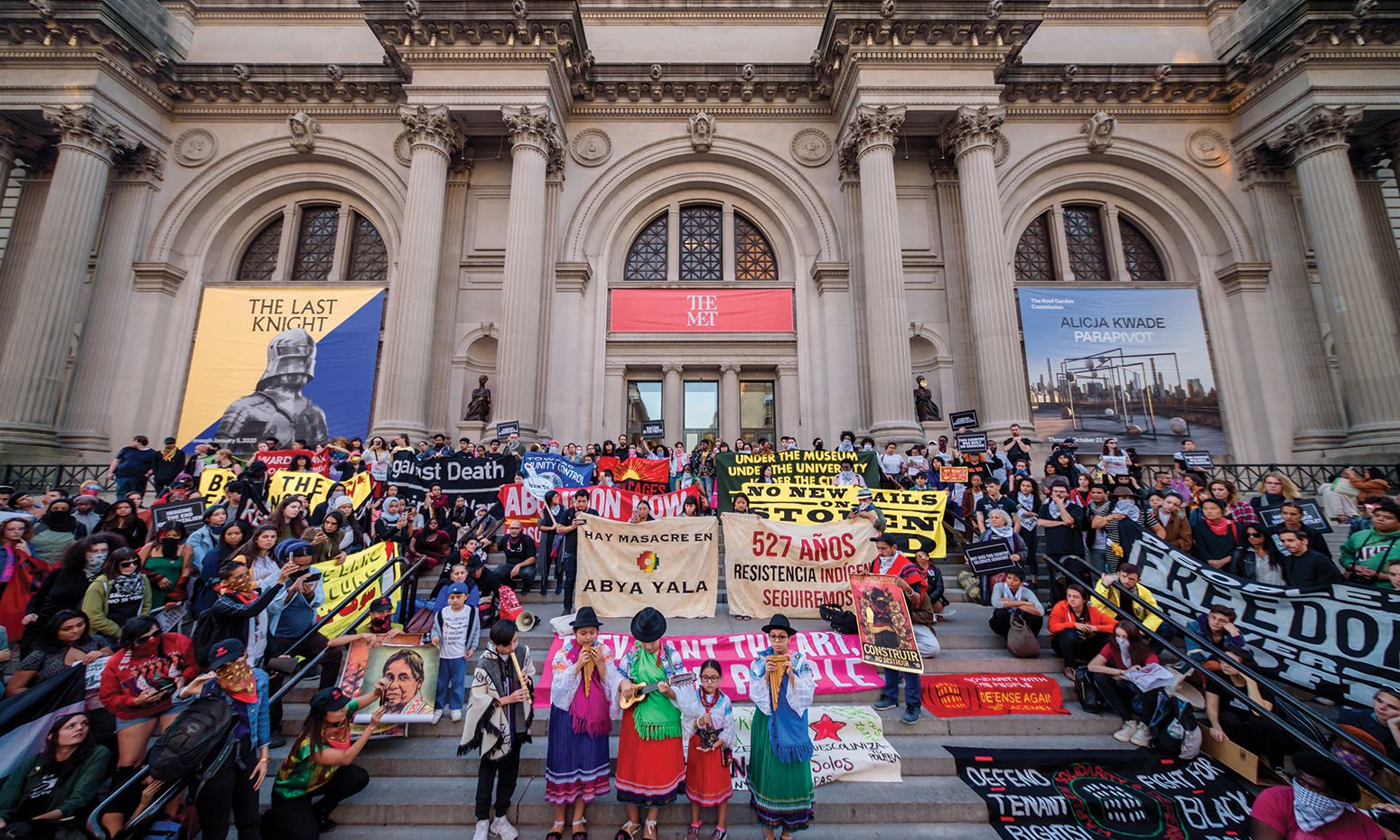Step it up: Indigenous artists perform at a decolonisation rally outside the Met museum, New York. Photo: Erik McGregor/LightRocket via Getty Images.
Ongoing Indigenous protests across the US and Canada are forcing cultural institutions to engage, often for the first time, in an increasingly unavoidable question—who owns the land on which museums stand, and how do they properly recognise the demands of newly recognised Indigenous artists?
Today, museums are now undergoing a “major transformation of historical proportions”, the curator Patricia Marroquin Norby (Purépecha) says, in a bid to acknowledge their ties to colonialism and recognise Indigenous rights. But are they doing enough?
Examples include the Royal British Columbia Museum in Victoria, Vancouver Island, which is to revamp its Indigenous gallery after the displays were criticised for their dehumanising depiction of Indigenous people; Vancouver Art Gallery, which has enlisted a group of First Nations artists to consult on its Herzog and de Meuron-designed expansion; and the Smithsonian Institution’s forthcoming Renwick Invitational in Washington, DC, organised by Lara Evans (Cherokee Nation), the first time the prestigious exhibition will comprise a line-up solely of Indigenous artists.
But perhaps the biggest change comes from New York’s Metropolitan Museum of Art, which, in 2018, faced criticism from the Association on American Indian Affairs over its long-term exhibition of Indigenous antiquities from the Charles and Valerie Diker Collection, which included ceremonial and funerary objects.
The museum has since rotated the exhibition, added labels throughout to offer Indigenous perspectives on certain works, installed a land acknowledgement plaque on its façade, and appointed Norby in the new role of associate curator of Native American art.
These changes were “not reactive” but part of a long-term effort to foreground Indigenous voices, says Norby in an interview with The Art Newspaper.
“Currently, museums and other cultural institutions are undergoing a major transformation of historical proportion by publicly acknowledging their own colonial legacies and reckoning with long-term institutional practices that have created long separations between collections and source communities,” she says.
“The current wave of change within the Indigenous art and museum world is not sudden. It has been long coming and is long overdue.”
Norby notes actions the Met museum had already taken before her arrival, such as the purchase of Kent Monkman’s monumental Great Hall commission, Mistikôsiwak (Wooden Boat People) (2019). As well as her curatorial responsibilities, Norby is advising the museum on issues regarding repatriation, collections care and exhibitions. “Caring for and presenting Native American and Indigenous art in a respectful, meaningful way that strives to uphold tribal sovereignty and culturally specific protocols is critical,” she says.
While these gestures mark positive change, some argue the museum sector could do more. The artist Jaune Quick-to-See Smith, who became the first Indigenous artist to have a painting in the collection of the National Gallery of Art, Washington, DC, says museums still tend to steer their acquisitions budget toward white artists, and that contemporary Indigenous art remains undervalued.
“The National Gallery didn’t buy my painting and neither did the Met,” Smith says. “They only hold my work because, in both cases, it was donated to them. A museum will spend almost their entire acquisition budget on a Jasper Johns print rather than buy work from the Native artists in their own community. We’re still largely represented as a dead culture, which is why it’s crucial to encourage and support living Indigenous artists.”
Black American and Latinx focus
Discourse around Bipoc (Black, Indegenous and People of Colour) representation in US museums has also primarily focused on Black Americans and Latinx communities, the artist argues.
“For example, a job opened up for a Native American scholar and it was given to an African American woman,” Smith says. “I’m not saying we should not have a person of colour for the role, but we now have many qualified Native people who are experts in fields that would feed into a museum.”
A study by the American Alliance of Museums, the Association of Art Museum Directors and the Andrew W. Mellon Foundation in 2018 revealed that “American Indian or Alaskan Native” people accounted for only around 1% of a 20% increase in leadership roles given to Bipoc museum staff since 2015. Although several high-profile Indignenous appointments have been made since then, the number of Indigenous staff at major museums remains low; the Smithsonian confirms that 1.4% of its current staff is Indigenous, while the Met has two Indigenous members of staff.
Land acknowledgements, or formal statements that aim to recognise Indigenous nations as the unceded owners of a specific region, have been widely implemented by cultural institutions since around 2017, but have been criticised by Indigenous communities for being performative and for ignoring more important conversations around the Land Back movement.
The Tlingit/Unangax artist Nicholas Galanin—who created the monumental work Never Forget (2021) for Desert X this year, which appropriates the Hollywood sign with the words “Indian Land”—says that land acknowledgements “often serve to appease the guilt of those saying them, with no direct action to the community that has been impacted by genocide, forced removal from homelands, displacement, removal of children, subsistence rights, the theft of cultural objects and so on”.
“This work is long-term and requires thoughtful collaboration,” Norby says. “This takes time. It cannot be done reactively or be rushed.”
But, as Land Back protests continue, and as cultural institutions continue to pledge to listen to the perspectives of Indigenous artists and activists, more immediate actions may soon be needed before the past can truly be reconciled.

